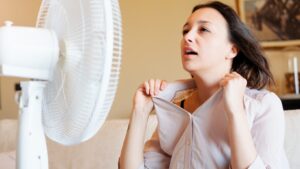What are Hot Flushes?
Hot flushes are the most commonly reported symptom of women going through perimenopause and menopause, with 75% of women experiencing them at some point. Flushes occur due to lowered levels of oestrogen, but it is not fully known why we get hot flushes. Research suggests that it is due to mixed up communication between the brain and hormones. The body’s thermoregulatory centre is situated in the hypothalamus, and scientists believe that as the ovaries reduce their production of oestrogen, this reduces the body’s temperature tolerance levels. Tiny fluctuations in core body temperature can bring on moments of intense internal heat. Symptoms will include sudden heat which spreads through the body (most often the torso and head) resulting in heat in the head and face accompanied by sweating.
Hot flushes can vary in intensity, frequency, and duration, so for some women they happen regularly day and night, while others only experience the odd one here and there. Hot flushes at night are usually called night sweats, where women alternate between intense heat with profuse sweating followed by feeling chilly. Other triggers for hot flushes include stress and anxiety, caffeine, alcohol, sugar and chocolate.
Stress and Anxiety
The adrenal glands are small organs located on the top of each kidney and are responsible for producing hormones that regulate many functions including metabolism, blood pressure and stress response. The adrenal glands produce cortisol which regulates stress response and aldosterone which regulates blood pressure. As our ovaries stop producing oestrogen, the adrenal glands take over and become the only source of production of oestrogen. If the adrenal glands aren’t working optimally (usually due to long term stress, illness or poor diet) symptoms can occur such as fatigue, insomnia, weight gain, muscle issues and low mood – otherwise known as adrenal fatigue. As you’ll see these are all symptoms common with perimenopause and menopause, suggesting that if our adrenals are overworked already before we hit perimenopause, we’re more likely to struggle with symptoms.
The adrenal glands will also prioritise the release of cortisol (in response to stress) over the production of oestrogen, so if we are stressed or anxious, our oestrogen is likely drop even lower. As a result, symptoms such as hot flushes are more likely and can be more severe the more stress we experience. Therefore, stress management is a key factor is managing and reducing hot flushes.

Natural Treatments for Hot Flushes
Conventional treatment for hot flushes is to replace oestrogen with HRT to raise oestrogen levels. However, HRT can come with side effects and simply delays menopause, so many people prefer a more natural way to go through this transition period. There are many ways to establish internal balance to lessen symptoms and go through menopause naturally:
- Stress management – breathing exercises, yoga and meditation are all proven to lower stress, help sleep therefore reducing menopause symptoms.
- Low impact exercise can help increase serotonin levels thereby reducing stress levels and helping us to sleep better, e.g. walking, low impact aerobics, yoga, pilates, jogging and weight training.
- Vitamin E can help reduce stress and hot flushes.
- Vitamin D can help lift mood and increase immune function and reduce stress.
- Zinc, Magnesium and Omega-3 are all proven to lower hot flushes.
- Turmeric, Ginger, Black cohosh, liquorice root, Maca powder, red clover and Sage are all known to help reduce hot flushes.
- Cut down on sugar and alcohol, and eat whole, fresh foods, balanced with plenty of fruits and vegetables, healthy fats, and protein.

Homeopathy for Hot Flushes
Homeopathy has been proven to help alleviate symptoms of menopause including hot flushes, and I have seen in the clinic and personally just how effective homeopathy is for women. In one study 90% of women reported the disappearance or lessening of symptoms within 15 days of starting with homeopathic treatment: https://pubmed.ncbi.nlm.nih.gov/18194760/#:~:text=Ninety%20percent%20of%20the%20women,in%20menopausal%20women%20is%20effective.
Below are a few of the main homeopathic remedies for hot flushes:
Sepia
Sepia is a main remedy for treating menopausal hot flushes, especially when the hot flushes are accompanied by drenching sweats moving up the body with exhaustion. Flushes are accompanied with anxiety, sweat, weakness with a tendency to feel faint. Individuals will be emotionally very sensitive, irritable with partners or children and easily nervous. They are tired and worn out with a dragged down feeling emotionally and physically. Sepia patients can be depressed with apathy (not interested in anything) along with weepiness, with a strong aversion to being around others. Generally worse for cold and better for vigorous exercise.
Amylenum Nitrosum
This remedy will help people who experience severe hot flushes followed by drenching perspiration and exhaustion. The head gets hot with a flushed face often with headache. There is often chilliness after the hot flush, with pale face and a sensation of lump in the throat with palpitations. High blood pressure is a feature, with blood coming up the face. Anxiety is felt in the head and chest, as if something bad is about to happen, with restlessness and fear on waking. They can be forgetful, with no joy felt and crave fresh air.
Lachesis
Another key remedy for treating hot flushes, Lachesis works on the circulatory system and suitable for hot flushes felt on waking and on falling asleep especially on the vertex (top of the head). For night flushes especially when sleep is disturbed by the heat, accompanied by palpitations. There may also be left sided headaches, with the head feeling too full; menstrual flooding and bloating after eating with the individual being intolerant of tight clothing especially around the neck (skin feels too tight). There will be mood swings, much talking, irritability, jealousy and suspiciousness and restlessness. Worse in the morning and worse for coffee.
Sulphur
In sulphur there will be a sensation of heat throughout the whole body and the heat includes the head, hands, and feet. There will be profuse sweats at night especially on the back of the neck. Flushes will be frequent, severe, and sometimes with faintness. There will be burning redness of the face and sweat on only one side of the body. They will be worse for heat and better for cool fresh air, and very thirsty.
Sanguinaria
In Sanguinaria the hot flushes are boiling, coming up with heat rising to the head – often described as ‘burning heat and ebullitions. There is a feeling of congestion and fullness of the head with hot, red face and hot hands and feet. Hot flushes are often felt around 3am and can feel as if hot water is poured over the abdomen. Flushes can be accompanied by a burning sensation in the mouth. Individuals needing this remedy may look in control but inside feel vulnerable and weak, with fear of sudden noises and a helpless feeling. There is fear, apprehension, and dread, especially fear at night. Better for sleep and cool air, worse at night (3am) sweets and touch.
Glonoine
Glonoine is indicated in cases where there is flushing with heat to the head. Frequent episodes during the day and sudden onset of hot flushes with pressure to the head with vertigo. Blood rushes upwards, suddenly, and violently. Worse for heat of the sun and hot weather, better for cold applications.
I hope this blog has helped you to find the information you need to navigate menopause symptoms naturally. It can seem a little daunting to see all the different homeopathic remedies together. If you’re feeling overwhelmed, then please do get in touch for a free 15 minute chat to find out how homeopathy can help you – Free 15 Minute Call
I’m now also offering a special bespoke Menopause Package which includes a full initial consultation and 2 follow up. It also includes information on diet, lifestyle and discounted Cytoplan supplements as well as a homeobotanical herbal blend. Please get in touch for more information.
You can also join our Facebook group – Homeopathy for Perimenopause and Menopause Symptoms for more information and advice


